Continental
Drift
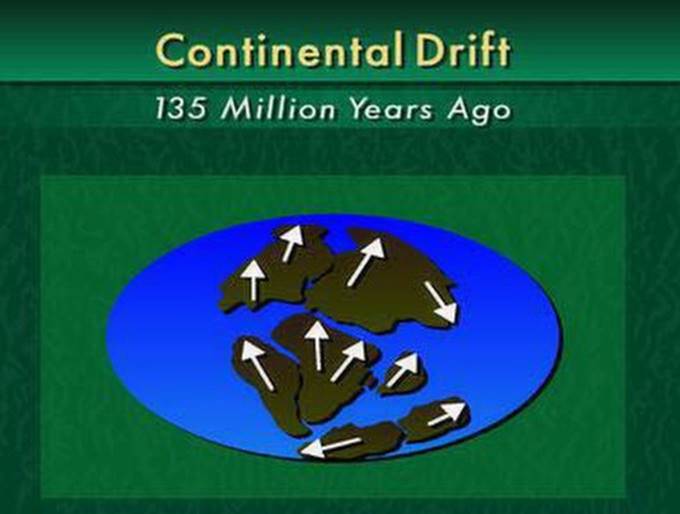
Geologists
have divided the Earth's crust into sections called plates.
Continental
drift is related to plate tectonics.
The
plates are always slowly moving, thus moving the continents.
Arrows
show the direction of movement.
Earth
Today
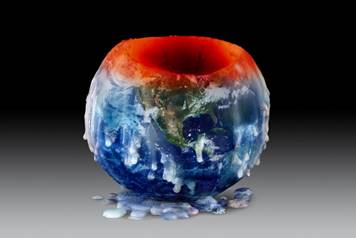
Global Warming
You have seen how Earth has changed in the
past. You might not know it, but Earth is still changing.
In this unit, you will explore what our planet
is like today, including its surface features and life forms, and learn how
change is happening around you.
Think about changes you notice in a day or a
year.
Consider what your town or city looks like, what
other places around the world are likeóand why they might be different.
In your science
journal, answer these questions.
1. Write down three
changes that are happening to Earth now.
2. Pick one of those
changes. What do you think it means for Earth's future?
Look at the map of Earth today.
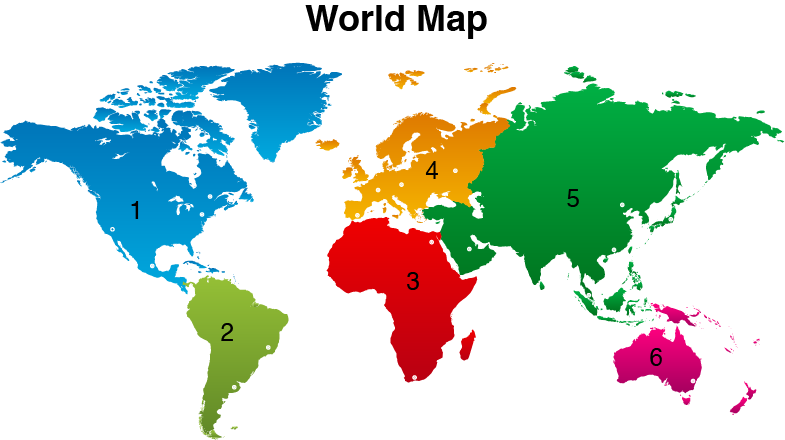
3. ††Name the continents on the map.
4. ††Which continents were easy to name?
5. ††Which continents were harder to name?
6. ††Which continent do you live on?
7. Which is the closest continent
to where you live?
Continental
Drift
Early Earth did not look like Earth today.
Earth has seven continents:
North America, South America, Europe, Africa, Asia, Australia, and Antarctica.
During the Paleozoic Era, Earth had only one
big supercontinent, Pangaea. This was the last time the
continents were all together.
Scientific evidence suggests that continents
came together and broke apart several times before and after Pangaea. For
instance, before Pangaea, continents were joined for the first time as the
supercontinent Ur during the Hadean Eon; Ur then broke apart during the Archean
Eon.
Pangaea formed 200 to 250 million years
ago. It left fossil and rock clues that helped scientists understand how
continents on Earth have moved around. Pangaea broke into two:
- Gondwana, which included South America, Africa, Australia, and
Antarctica
- Laurasia, which included North America, Europe, and Asia
Over time, parts of Gondwana and Laurasia moved
apart, eventually forming the seven continents we have today. Continents did
not break up all at once and moved away from each other. It took millions of
years.
The movement of continents is called continental drift.
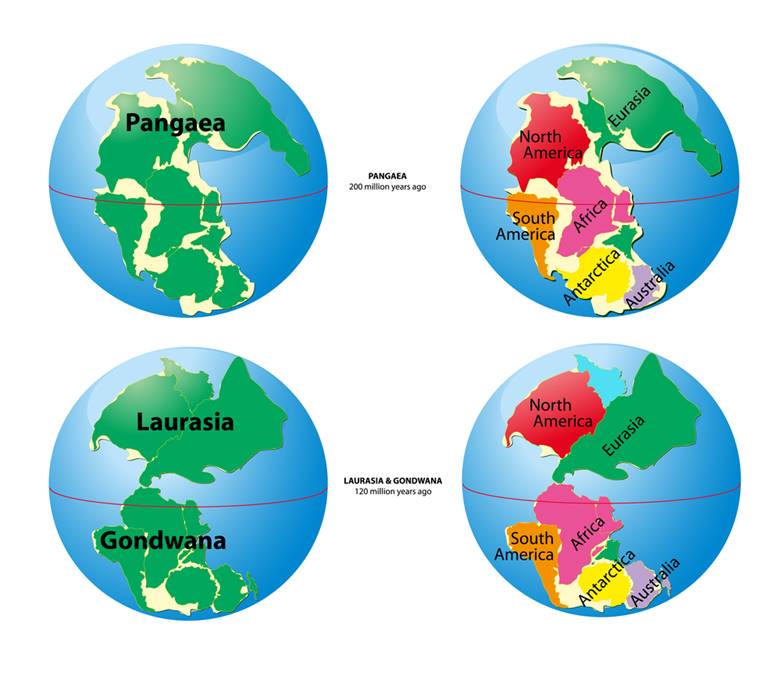
Images that illustrate
continental drift.
In your science
journal,
answer these questions.
1. Describe a Pangaea.
2. Provide a hypothesis
that proves that continents are moving.
Continents
Moving
Watch the video below, then answer the
questions in your science journal.
1. How far apart (in
centimeters) are the continents now moving away from each other every year?
2. The Mid-Atlantic
_______ tears more and more each year as the continents move apart.
3. The continents were all
_______ 300 million years ago.
4. Do scientists think the
continents will ever come back together?
Alfred
Wegener
Geologists looked at the evidence from rocks
and fossils to decide that continents might have been together long ago. They
noticed that some rock formations and shorelines of one continent match another.
They also saw that fossils of animals and plants are similar in places now
separated by an ocean.
In 1912, a German scientist named Alfred
Wegener proposed that the continents fit together simultaneously. He
suggested that all the continents were once connected. Wegener said they were
once one big landmass. He called this landmass Pangaea, which means "all
land." According to Wegener, about 200 million years ago, Pangaea broke
into pieces. The pieces drifted away from each other. We call these pieces
continents. Wegner's hypothesis is called continental drift. Continental drift
is the hypothesis that Pangaea broke apart into continents that moved slowly to
where they are today.
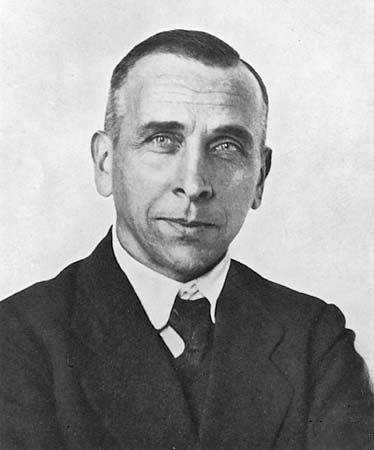
Alfred Wegener
Letís Practice:† Pangaea
Evidence
of Continental Drift
Alfred Wegener used fossils, climate, and rock
clues to support his continental drift hypothesis.
Animal fossils indicate that the
continents might have been joined millions of years ago. Fossils are the remains, imprints, or traces of prehistoric
organisms. Fossils can tell when and where organisms once lived and how they
lived. Look at the example below:
∑
The Mesosaurus fossils have been found in South America and Africa.
∑
Mesosaurus is a reptile that lived on land and in freshwater.
How could this reptile move between two
continents separated by a salty ocean? It is not likely that it swam across the
Atlantic Ocean. Wegener's continental drift hypothesis proposes that Mesosaurus
lived on both continents when they were joined together.
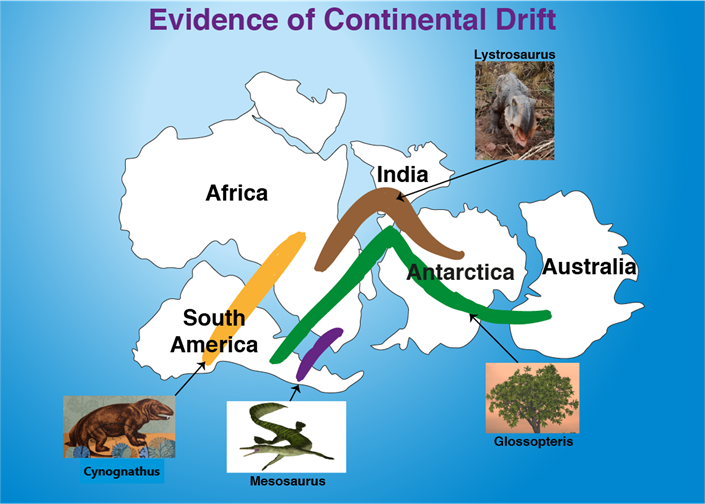
Mesosaurus was a
reptile that lived in freshwater about 286 to 258 million years ago.
Plant fossils support continental
drift. Look at the example below:
∑
Glossopteris was a type of plant that produced seeds.
∑
Fossils of this plant have been found in Australia, Antarctica,
Africa, and South America.
Because the plant and its seeds are large, they
could not have traveled to these present-day continents by drifting in the wind
or by being spread in the waste of birds. Finding Glossopteris in many areas
supported the idea that these regions once connected and had similar climates.
Climates support us about continental
drift. Scientists have found fossils of warm-weather plants on the island of
Spitsbergen in the Arctic Ocean. This is one of the coldest places on Earth.
How did this happen? Wegener's continental drift hypothesis proposes that
Spitsbergen Island drifted to the Arctic from a tropical region of Earth.
Rocks support us about
continental drift. Glaciers are large, slow-moving bodies of ice on land.
Glaciers leave tracks as they move, scouring and polishing rock surfaces under
them. They also leave deposits of glacial rock and sediment. Glaciers are found
in cold areas. Yet there are traces of glaciers and deposits in many tropical
and temperate regions of Earth. How is this possible? Wegener's continental
drift hypothesis says that millions of years ago, some tropical and temperate
lands had cold climates and were located near Earth's south pole. These continents
were joined together and partly covered with ice. When the continents drifted
apart into warmer climates, the glaciers melted away from these areas. The
glacial deposits left behind to add more evidence to support continental drift.
In conclusion, Wegener used rock, fossils, and
climate clues to support his continental drift hypothesis. Today, there is more
evidence for continental drift. After Wegener's death, new technology provided
new evidence. One of these ideas is called seafloor spreading. You'll read
about this in the next unit.
In your science
journal,
answer these questions.
1. What is continental
drift?
2. How do animal fossils
show evidence for continental drift?
3. What do rocks and the
shorelines of continents tell about continental drift?